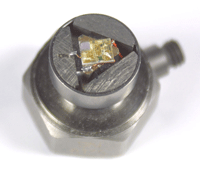| Tip of the
Month |
|
Mounting Irregular-Shaped Triaxial
Accelerometers
Certain
accelerometers - commonly triaxial units - are packaged in a
non-symmetric fashion, often with an off-center through-hole
mount. These
accelerometers can be the most challenging to calibrate because the
sensing element is not aligned with the sensor's center of gravity
or its intended mounting configuration. In order to get acceptable
results, the unit often needs to be mounted as a best compromise
between these. In other
words, if the triax is mounted with its through-hole and a large
amount of the sensor is consequently offset on the reference, a
significant amount of transverse motion can be induced causing
"glitches" in the calibration frequency response. For this case, the
calibration technician may be required to adhesively mount the unit,
avoiding the use of the more convenient through-hole threaded mount,
and perform trial and error with adhesive mounting to produce the
best calibration results. |
| Newsletter
Archive |
May 2007 - Basics of Accelerometer Function; How Standards Link Together
June 2007 - Shear,
Compression, Flexure; ISO 16063
Overview | |
|
| Accelerometer Transduction Types... |
...Piezoelectric, Piezoresistive and Capacitive
 Accelerometers are transducers that
generate an electrical signal output as a result of a
mechanical acceleration input to the unit. The most common type of
accelerometer operates by the piezoelectric effect. Piezoelectric
(PE) accelerometers are generally classified in two groups
- low impedance voltage mode (for example, PCB Piezotronics
trademarked ICP ®) or charge mode. Other types of accelerometer
transduction methods include piezoresistive (PR),
based upon strain gage technology, and variable capacitive
(VC).
Click here for the rest of
this article describing the basic technology of PE, PR and
VC sensors.
(http://www.modalshop.com/test_calibration.asp?ID=190) |
| Overview of
ISO-16063-11... |
 ...Accelerometer Calibration via Laser
Interferometry Method ...Accelerometer Calibration via Laser
Interferometry Method
Primary accelerometer calibration is at the root of
traceability for virtually every accelerometer calibration chain in
the world: commercial, government, military, academic or
vendor. Acceleration
calibration via laser interferometery is a primary method because it
is an absolute method comparing the measured vibration from a sensor
under test to a constant of nature - the wavelength of laser
light.
(http://www.modalshop.com/test_calibration.asp?ID=191) |
|
| As always, your satisfaction is at the pinnacle of our
work. If you have
questions that you would like answered, please contact us and we'll
be glad to help out.
Your question may even be featured in a future month...
Sincerely, |
|
Michael J. Lally The Modal Shop
A PCB Group Company | |